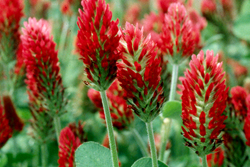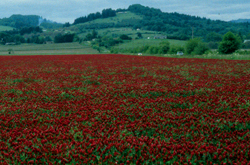Oregon-Grown Clover Seed
Oregon is the source of world class clover seed for pasture, cover crops or simply for beautification around the house.
- Attracts Beneficial Insects
- Reduced Animal Toxicities
- Healthier Soil
- Lower Nitrogen Fertilizer Costs
Crimson clover
The hills of the north Willamette Valley are beautiful in mid-May, when the crimson clover fields bloom scarlet red. Crimson clover is an annual, grown only for the seed here, not for the forage. Crimson clover is planted as soon as the fall rains start, usually in late September or early October, and the crimson clover seed is harvested in early July. Crimson clover flowers open from the bottom of the flower head to the top. Growers hope for cool, cloudy days during the bloom period, so the flowers will open more slowly, giving the bees plenty of time to visit each one. If the weather is hot and sunny, all the blooms open at once, and not every flower gets pollinated, making the seed yield lower. Crimson Clover Seed
Crimson clover seed is harvested in early July. It’s the first of the seed crops in the Willamette Valley to be harvested. As with the other clovers, it’s swathed at night, when dew is on the plants, to reduce seed shatter. It’s allowed to dry in the swath for about a week, then harvested with a combine using a belt pick-up header. Crimson clover seed is harvested early enough to escape insect problems and usually has fewer weeds than other clovers. There is risk to having clover plants too small going into the winter because frost heaving on some soils can break the tiny roots and result in winter kill. There is also a risk to having them too big. Early-planted crimson clover with lush foliage is more susceptible to Sclerotinia crown rot and wilt (Sclerotinia trifoliorum), which can suddenly defoliate a field in the winter. A well-established stand can re-grow, but yield is reduced. Oregon Clover CommissionUniversity of KentuckyForage Identification and Use Guide - Crimson Clover University of George |
Copyright © 2018 - All Rights Reserved